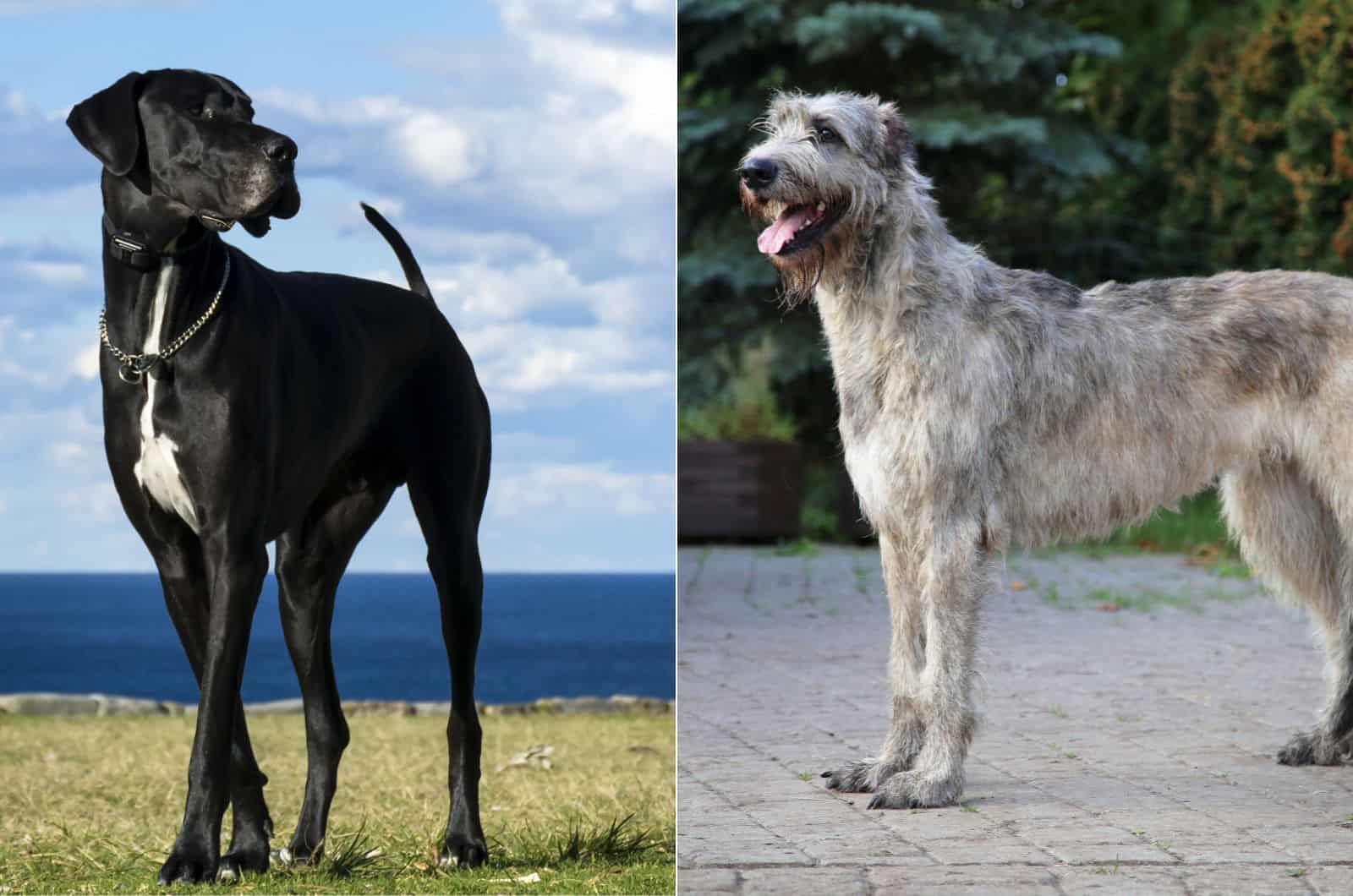Designer dogs usually project an image of a small to medium-sized mixed breed that is portable or at least a comfortable lap dog. An Irish Wolfhound-Great Dane mix is an unlikely competitor in the “fashion” dog category.
The more you find out about each constituent breed, the more appealing this mix becomes. Being big and strong does not disqualify a dog breed from having a gentle and calm temperament. Without further ado, here is the Irish x Danish eurodog competition winner.
How Does An Irish Wolfhound Great Dane Mix Come To Life?
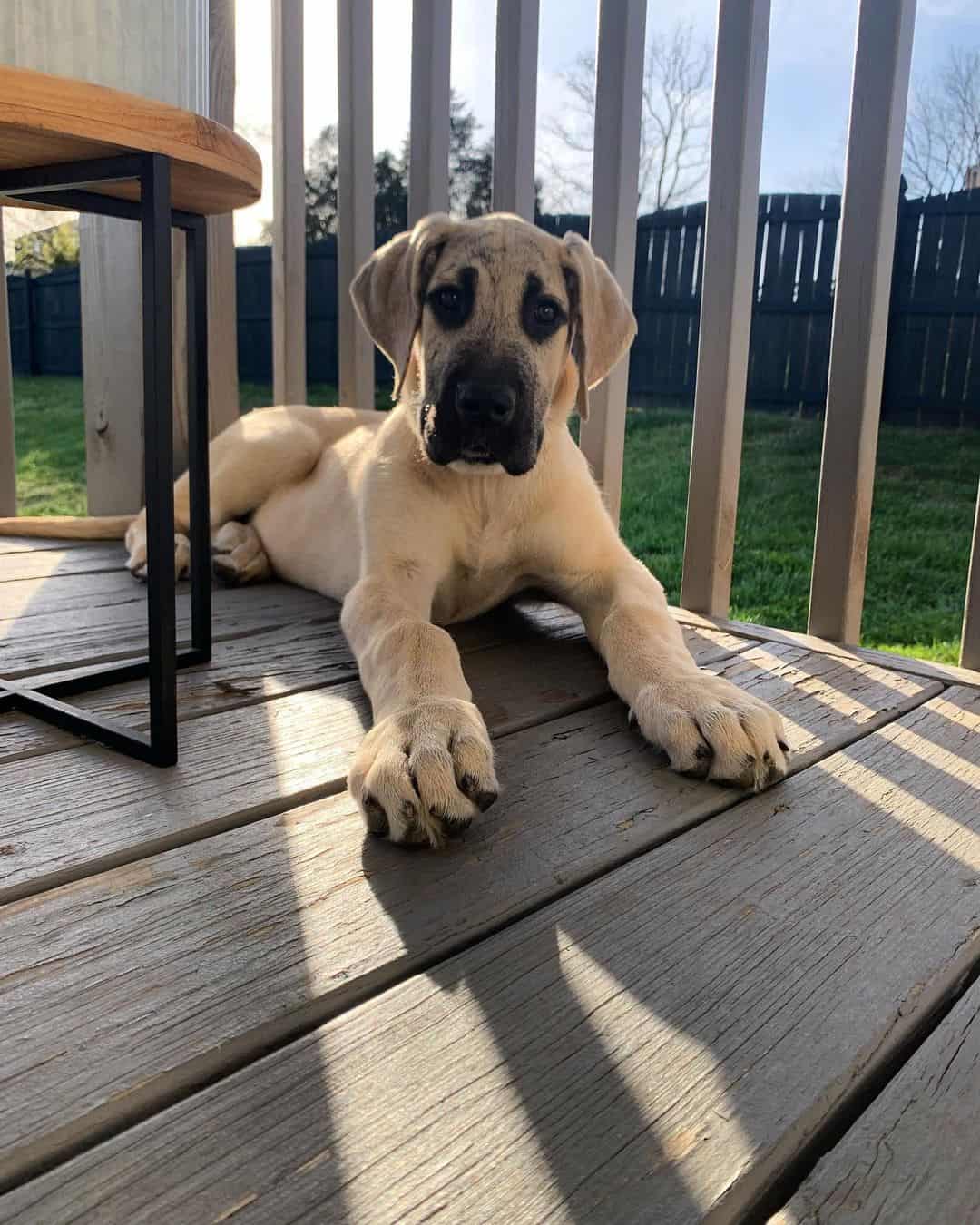
Photo from: @nikole0070
Though quite clear which two breeds make an Irish Dane dog, the story is a little bit more complicated.
Just like other dog breeds whose genetic features are melded to produce a dog with “special” or “improved” traits, this mix aims to create a dog more adept for its modern companionship role.
What is there not to love about giant dogs? They are imposing, protective, lazy when necessary, and can give you a good workout at least once a day. The arbitrary nature of inherited traits makes it difficult to predict what an Irish Dane will look like or act like.
This is because many times, the breeding ratio is not 50% Great Dane and 50% Irish Wolfhound. Since the breed is not recognized by the American Kennel Club, claiming a specific set of features is impossible.
This is due to an absence of a regulatory mechanism that lists the rules of breeding the mix. You are, essentially, playing the lottery if you want to get an Irish Wolfhound Great Dane mix. The number of features inherited from one breed or the other will depend on how mixed the genetics of the parents is.
If your puppy has a 50-50 parent, which is then bred to another 50-50, you are in for a game of guessing. The most common way of producing a breed that has the potential to become a pure breed is by breeding purebred Great Danes or Irish Wolfhounds to a 50-50 mix.
This way, breeders slowly instill the features they find desirable in one or the other dog. Once the features can be predictable, they can start inserting features of the other pure breed through cross-breeding. This is known as multigenerational breeding, and it applies to all crosses.
Now that you know a little bit about the way dogs are crossbred to produce a potentially new breed let us see what physical appearance and temperament you can expect from both sides.
All Things Irish Wolfhound
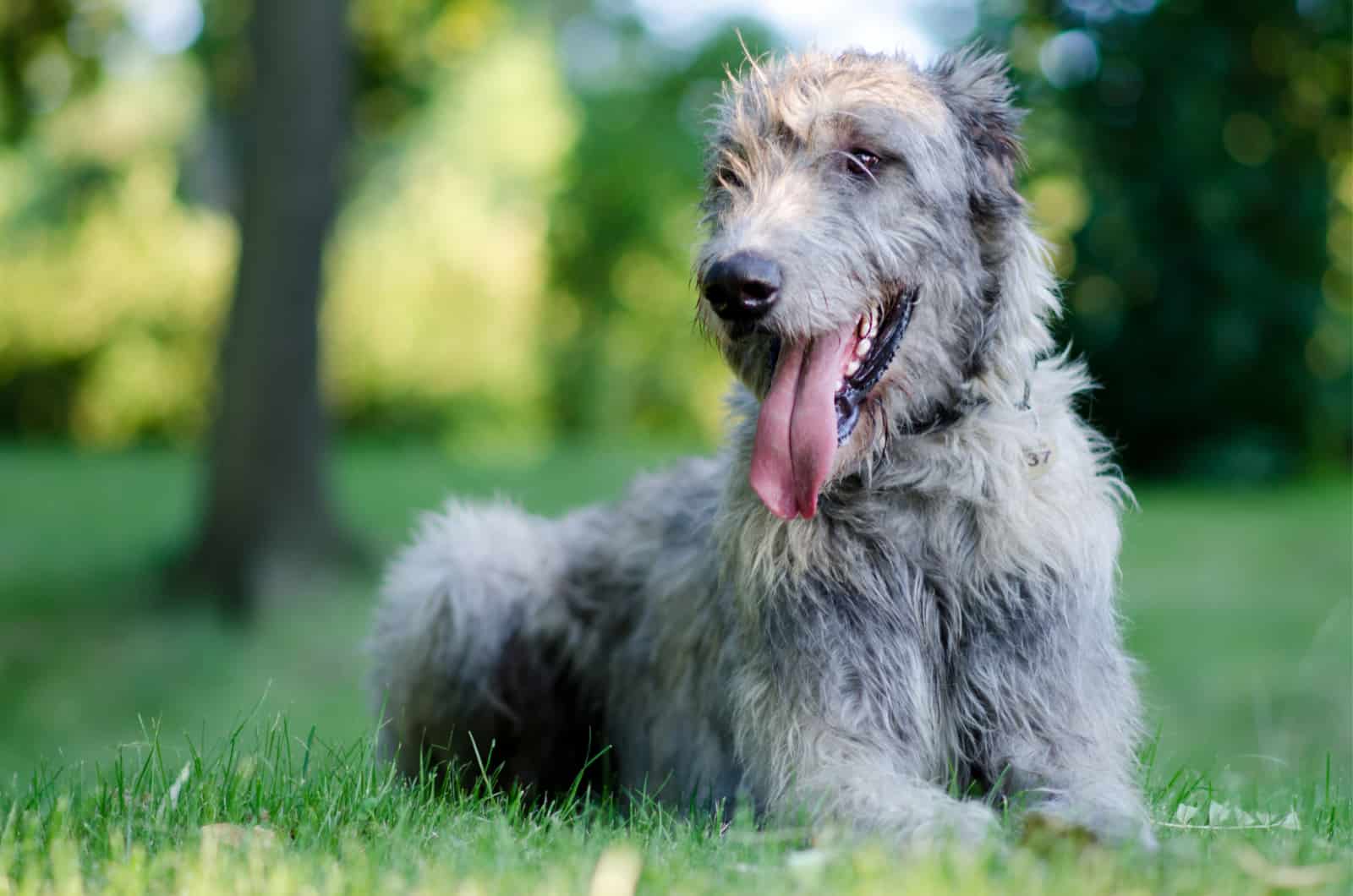
I believe it would be fair to provide some context behind the name first. We can agree that the “Irish” part does not need explaining. Clearly, the first record of their existence mentions the geographical location we now know as Ireland.
The Romans encountered this breed when they came to the British Isles, which means it had already been established by the time of their arrival. History undoubtedly points to indigenous Irish dogs being crossbred with Middle-Eastern coursing hounds to produce the Irish Wolfhound.
They were the perfect hunting dog for chasing and taking down enormous game such as the Irish Elk. This incredibly old type of deer has been extinct for a while, but the Wolfhound survived.
Tales have been written about its loyalty and courage, and influential people went to great lengths to preserve this iconic Irish canine.
So, what features of the Irish Wolfhound helped it become the fabric of nightmares for the elk? Here is the breakdown.
Physical Appearance
Known to be the tallest dog breed among all, a male Irish Wolfhound can grow up to thirty-two inches, with the female being ever so slightly shorter, up to thirty inches. They are not the heaviest breed. Males can weigh up to a hundred and twenty and females a hundred and five pounds.
The head is elongated with a somewhat pointed muzzle and small ears. The neck is very toned and lengthy, and it connects to a wide and deep-seated chest. The back is slightly arched at the loins, ending in a bushy, barely curved tail.
The feet and legs are positioned straight beneath the shoulders, giving it a very athletic frame. The nails should be durable and more curved than straight on a more than averagely large and rounded foot.
In terms of lifespan, the Irish Wolfhound has a rather short one. The breed can live from six to ten years of age on average, which is rather short, even for the giant breed category.
The Coat
They have a wiry, rugged coat that was immensely useful when sprinting through thorny bushes and tree branches hunting game. The coat appears rather long, but in reality, it is medium length.
One of the most interesting features of the Irish Wolfhound’s coat is that it has bushy eyebrows and a “wise man” beard.
Irish Wolfhounds shed a decent amount, but you do not have to groom them more than every other week or so. They can sometimes drool a little more than you would expect them to.
All the possible colors of an Irish Wolfhound are standard according to the AKC. This is the full list of solids an Irish Wolfhound can come in:
Black, blue, brindle, cream, gray, gray and brindle, red, red and brindle, red wheaten, silver, white, wheaten and wheaten and brindle. Markings can be present but are not officially recognized. Black, white, or gray is possible.
Temperament
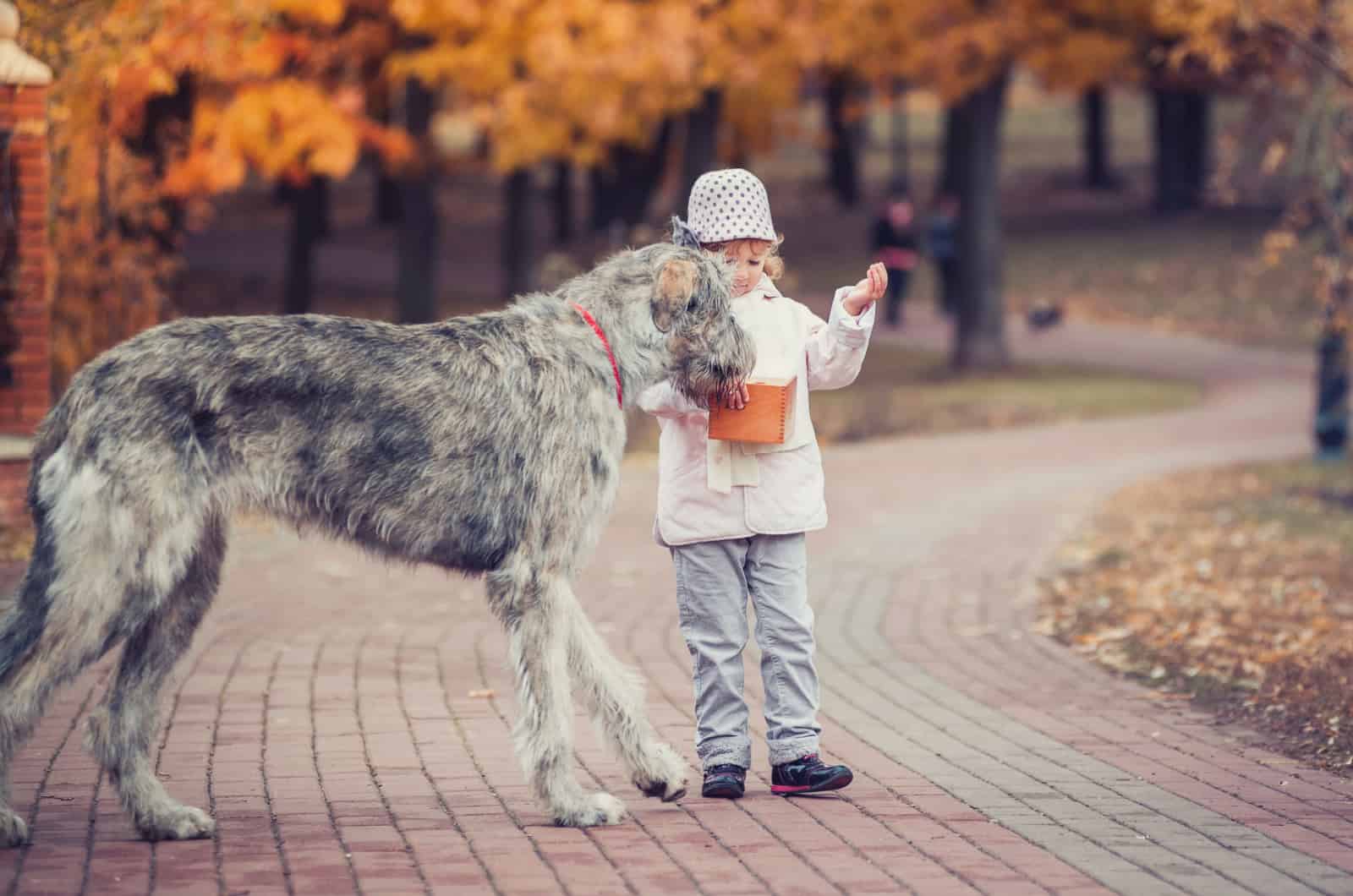
The legendary loyalty of the Irish Wolfhound comes second only to its love towards the family. Not many big dogs are this affectionate with their owner(s). They are tolerant of children but do not mistake them for an extremely playful dogs.
If you have other dogs, owning an Irish Wolfhound should not create a problem. However, since the breed has an incredible prey drive, smaller critter-type pets can get it to knock a vase or two while giving chase. They do retain a lot of the coursing dog DNA in their temperament.
Other than having an intense prey drive, they are decent watchdogs too. They have the physical predisposition to ward off intruders without barking excessively. They are, obviously, very sensible and can read a situation well.
Though Irish Wolfhounds require intense exercise, they do not have sky-high energy levels. Since they share a lot of their DNA with Greyhounds, they will couch potato quite a lot after getting the necessary exercise.
Trainability is average in this dog breed. If properly trained from an early age, they will be obedient and do most basic things easily. In terms of socialization, they should be exposed to any external influences that might work against their natural behavior.
Having strangers around an Irish Wolfhound should not be difficult, but they can get annoyed if not accustomed to guests coming over often. Since they are a giant dog breed, they can be quite intimidating to people who get nervous around dogs.
Despite their laid-back nature, stretching those long legs will require plenty of space. Life in an apartment will be great for the lazy side of an Irish Wolfhound but should be accompanied by regular exercise in the outdoors.
Health Problems
Giant dog breeds carry some genetic burdens associated with their size. A deep-seated chest, for example, can increase the risk of bloat or gastric dilatation and volvulus (GDV) in large-breed dogs.
Their genetics carry more than one health issue. Irish Wolfhounds are prone to von Willenbrand’s, hip dysplasia, osteosarcoma, and progressive retinal atrophy, among others. Here is a short description of each.
Bloat And GDV
Large dogs can have large problems. Eating too much too fast or eating only one big meal a day can cause bloat in Irish Wolfhounds. It occurs due to trapped gas in pockets between undigested food. Once the gas starts expanding, the stomach becomes distended.
Gastric dilatation and volvulus are a progression of bloat. If the bloat does not resolve itself or by a veterinarian, the stomach will start to get bigger and bigger until it twists completely.
The twisting causes both the entry and exit to the stomach to be blocked, which means there is no way out for the gas. The pressure GDV exerts on the arteries, veins, and blood vessels around the heart can cause the dog to collapse, with the potential of becoming fatal.
Von Willenbrand’s
The disease is congenital and, in most cases, hereditary. It is characterized by the lack of a certain protein that helps in clot formation. Dogs that undergo serious injury or surgery that implies bleeding can die due to excessive hemorrhaging.
Since a cure for this disease does not exist, breeding dogs with this genetically engraved condition is unethical. Some other breeds that have a predisposition for von Willenbrand’s include German shepherds, Dobermans, poodles, etc.
Osteosarcoma
Cancers are part of this genetic predisposition. Osteosarcoma means bone cancer, and it affects a very large number of dogs. The cancer is invasive and aggressive, which means it spreads fast and causes quite a lot of pain.
Diagnosing osteosarcoma is quite complex, and treatment usually implies surgery. The treatment options will heavily depend on the individual case, so radiation therapy is a possibility.
Hip Dysplasia
It is much more present in large dog breeds than small ones. It is a congenital deformity and includes an unequal growth of the ball and socket joint during a puppy’s early years.
Because of this, the fit of the two parts is not perfect, and it creates unwanted friction. The friction causes more deformation and damage to the blood vessels in the tissue, ultimately ending with arthritis.
Progressive Retinal Atrophy
While this is not a single condition but rather a group of conditions that affect the dog’s vision, it involves various degrees of blindness caused by a faulty gene from one of the parents.
The most common type is progressive rod-cone degeneration. The “connectors” between the eye that carries over the image to the brain start dying, causing night vision loss followed by day vision.
It’s A Great Dane To Start The Day
Since we started off with the tallest dog breed in the world, I think it is only appropriate that we proceed with the second tallest dog breed in the world. That aligned very nicely.
The breed has German heritage, but for some odd reason, it is called Great Dane. Without any links of its origin being in close connection with Denmark, the naming is quite misleading. In Germany, the breed is known as the German Mastiff (Deutsche Dogge).
People often refer to them as “gentle giants” due to their highly sensitive nature towards owners, but the dog is known as a “war dog”. That is primarily due to the physical appearance that history saw fit to describe as the “Apollo of dogs”.
Great Danes were originally bred as boar hounds but were later used, and still classified, as a working dogs. The only work they do nowadays is to make people happy.
You probably know the Great Dane named Scooby-Doo, so you will enjoy this little fact about the breed. In medieval times, they were believed to have the ability to scare away phantasms from properties. I guess Scooby Doo was doing the Uno reversal.
Physical Appearance
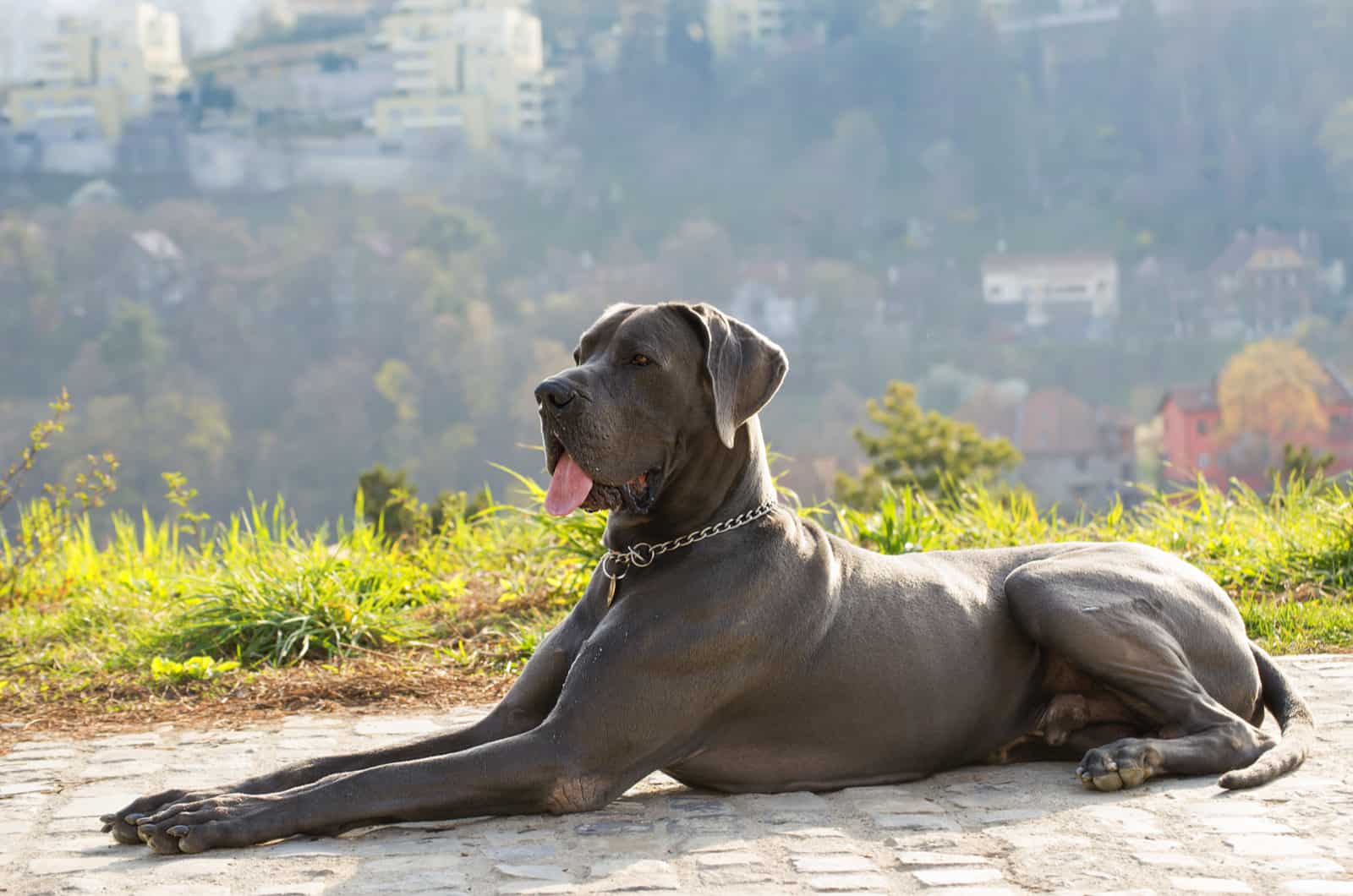
At thirty to thirty-two inches of height for males and twenty-eight to thirty for females, the Great Dane comes very close to the Irish Wolfhound’s tall frame. Where it does “better” is the weight department.
Great Danes are significantly heavier than Wolfhounds, with a hundred and forty to a hundred and seventy-five pounds for males and a hundred and ten to a hundred and forty pounds for females.
Their head shape and body frame are much more rectangular, with the bones themselves being quite denser and thicker than in the Irish Wolfhound. The ninety-degree angle between the end of the long muzzle and forehead is clear, unlike the more sloped Wolfhound transition.
Ears differ quite clearly from the Irish Wolfhound’s Greyhound-like shape. The Great Dane has large and hanging ears that level with the top of the skull at the fold.
The chest is deep-chested, just like with the IW, but the back is straighter. Equally straight, the feet are perpendicular to the shoulder joint, with the nails being the opposite of the IW’s — short and straight.
A Great Dane will live between seven and ten years of age. This is slightly longer than the Irish Wolfhound, but health complications can shorten the lifespan significantly.
The Coat
Being smooth and short, the coat is a contrast to the wiry medium-length one of the IW. Dog owners will rejoice as Great Danes come in plenty of colors too. Unfortunately, not all are standard according to the AKC.
Seven colors or patterns are acceptable for show dogs: brindle, fawn, blue, black, harlequin, mantle, and merle. There are quite a few marking variations for each pattern, but most include black around the eyes and on the nose.
Temperament
The loyalty and affection trend is deeply embedded in large dog breeds. The Great Dane will serve you loyally and lovingly until its last breath. They are tolerant of children but less willing to share the home or attention with other dogs.
Unlike IWs, Great Danes are no strangers to channeling their inner puppy, so playfulness is on a quite impressive level. Strangers are not their favorite thing in the world but will be allowed to be in your house as long as they are not brash or invasive of the dog’s space.
Great Danes are better watchdogs than Irish Wolfhounds but require very structured dog training and socialization from puppyhood. The same story about activity levels applies here, too — they need intensity but will also gladly play dead on the sofa.
Make sure you have the actual space to home this colossus. They will need a lot of empty space to get enough exercise. Even when resting, they are so big and can double as an enormous pillow.
They are good barkers and have higher energy levels than IWs, but they can be very stubborn. You better train that Great Dane or you might find yourself sleeping in the dog bed. It is not all about physical exercise, as they require mental stimulation too.
Health Problems
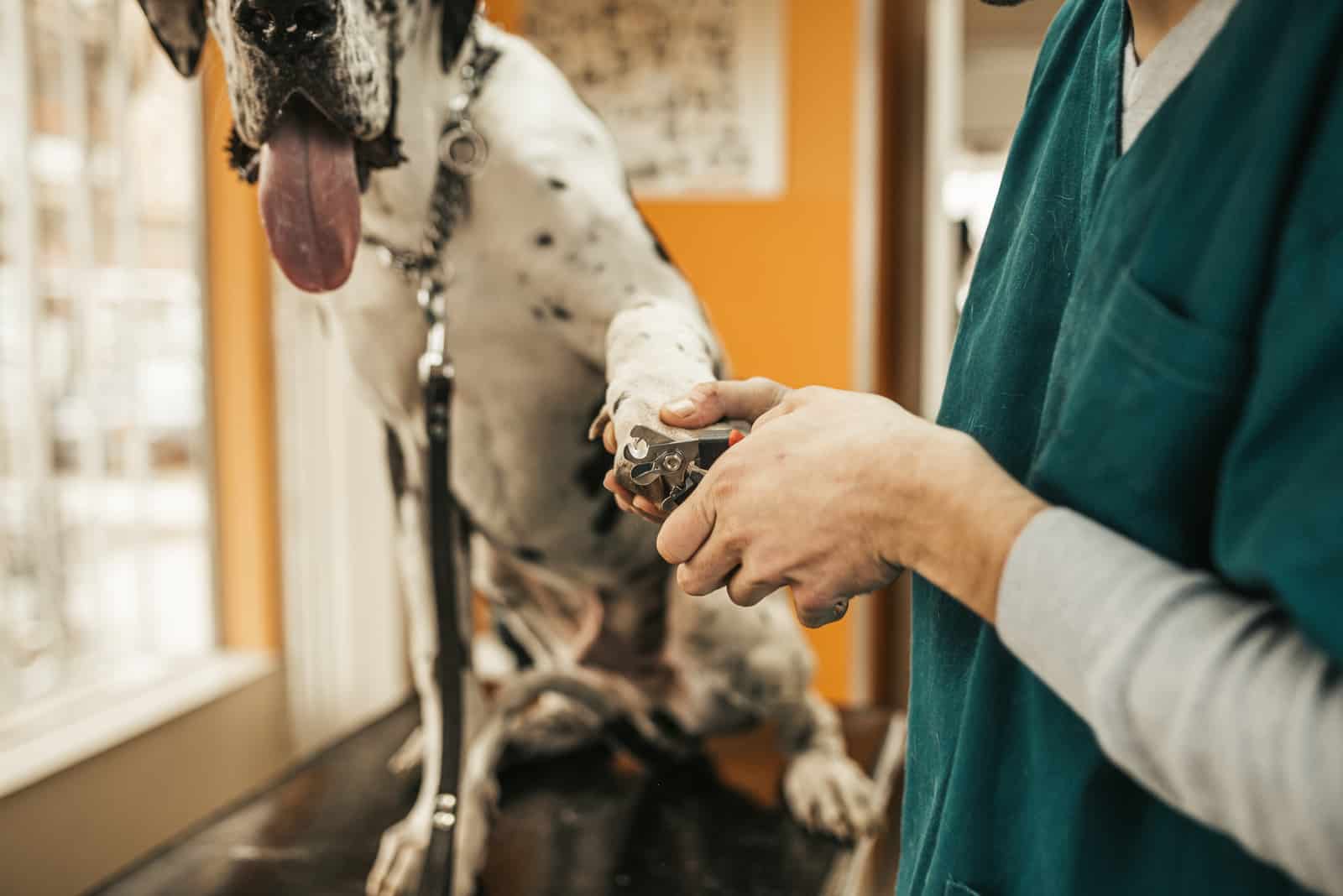
Most of the problems encountered in an Irish Wolfhound will plague the Great Dane too. However, let us add a couple more conditions that love to meddle in the lives of giant dogs.
Cardiomyopathy
The full name of this disease is Canine dilated cardiomyopathy, or DCM for short. Great Danes are infamously susceptible to “enlarged heart”, so here is a breakdown of why and how it happens.
Essentially, it is a condition that causes the thinning of the heart muscle, in particular, the wall of the left ventricle. This degeneration of muscle makes the heart lose its ability to distribute blood around the blood system.
The blood that the weakened heart cannot pump out starts putting a lot of pressure on the walls and causes the enlargement of the organ.
Causes are largely unknown but can be closely connected to genetic predisposition, nutrition quality, or bacterial, fungal, and viral infections.
Hypothyroidism
Hormonal disbalances are very difficult to treat. They usually require lifelong treatment to maintain healthy levels of hormones in the dog’s body. Hypothyroidism is the underproduction of the two hormones (thyroxine and triiodothyronine) the thyroid gland produces.
These two hormones regulate some key body functions such as body temperature, metabolic rate, and nutrient absorption. Hypothyroidism is usually caused by an autoimmune disease or thyroid tumor.
Middle-aged dogs that belong to large dog breeds are the highest risk group regardless of how well taken care of the dog is. American Bulldogs are especially prone to hypothyroidism.
Osteoarthritis
Hip dysplasia and osteoarthritis are two inseparable buddies that wreak havoc in a dog’s body. Osteoarthritis causes the joint cartilage to degrade until it is completely gone.
Once there is no soft and smooth mass between the ball and the socket of the joint, new bone tissue starts forming, creating a thickened joint that, with time, loses function.
Oftentimes, dogs with dysplasia have osteoarthritis, which impairs their normal movement. Treatment is usually NSAIDs for mild cases and surgery (including hip replacement) in severe cases.
Summarizing The Two Into The Irish Dane
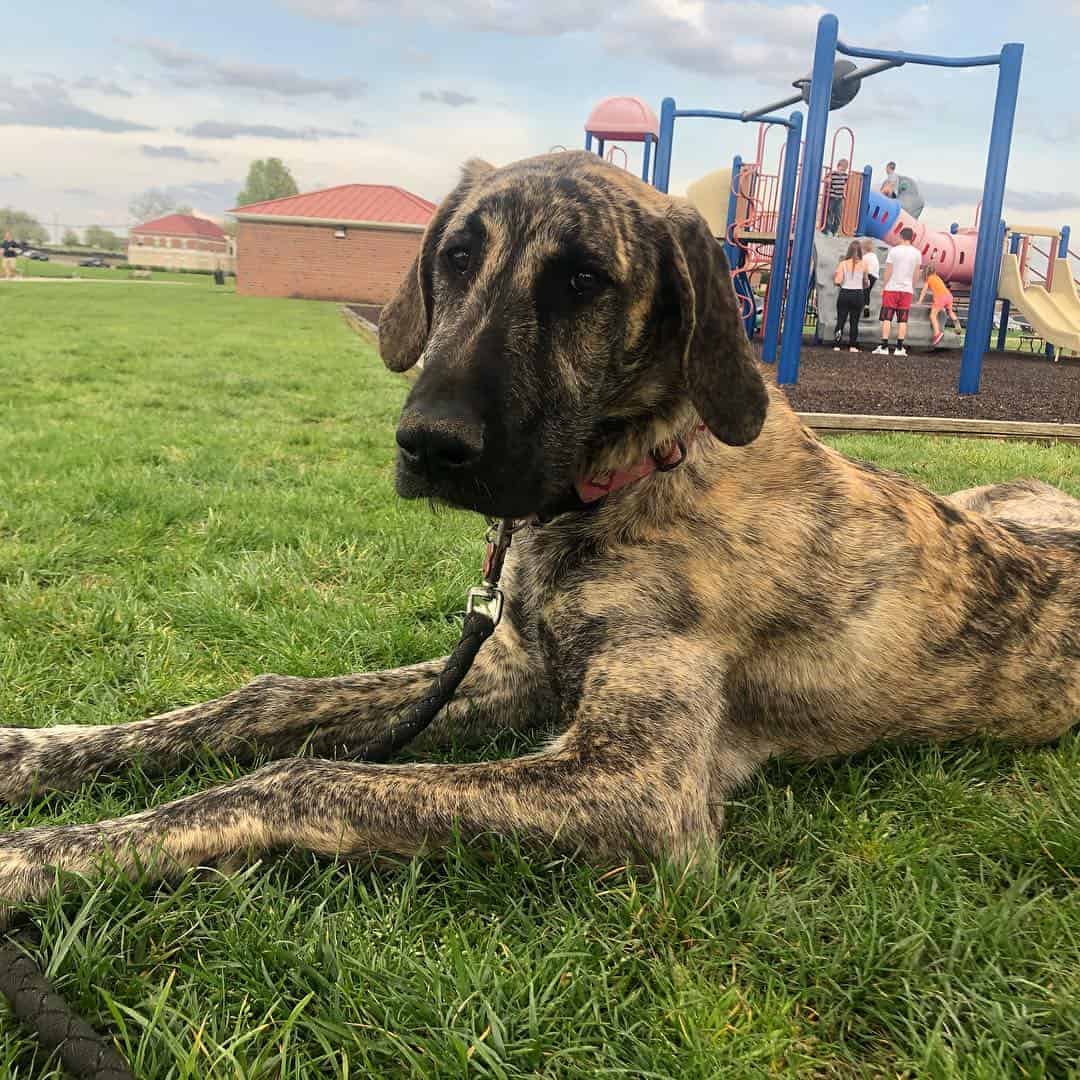
Photo from: @crazyeightsfarmlife
With all that we learned about the two parent breeds, it should be quite clear what this hybrid dog called the Irish Dane is all bout. Well, not quite. Remember the multigenerational crossbreeding we talked about at the beginning? That is the barrier to having a precise image of the Irish Dane.
Mixed-breed dogs are always tricky to predict in terms of physical features. The match is good in terms of temperament because both breeds have similar traits. With the appearance, you might get something that looks like an Irish Wolfhound mix without any physical traits of the Great Dane.
Similarly, you could get a beautiful dog that looks like a Great Dane but is more aloof, like the Irish Wolfhound. However, there is a certainty of getting two things: a colossus of a canine and an amazing family dog.
The interchangeable features of both breeds fold one into another, creating layers of nuances that fall together nicely. The Irish Dane will likely be muscular and tall, but the other features are up for grabs by either gene pool.
Two organizations dealing with breed recognition and registration have accepted it as a mixed breed — The American Canine Hybrid Club (ACHC) and the Dog Registry of America (DRA).
Though the hybrid is still far from being recognized by authorities such as the AKC or FCI, some improvements were created with crossbreeding. There has been information from unconfirmed sources that the Irish Dane has a slightly higher lifespan than its parent breeds.
How Will I Recognize Irish Dane Puppies?
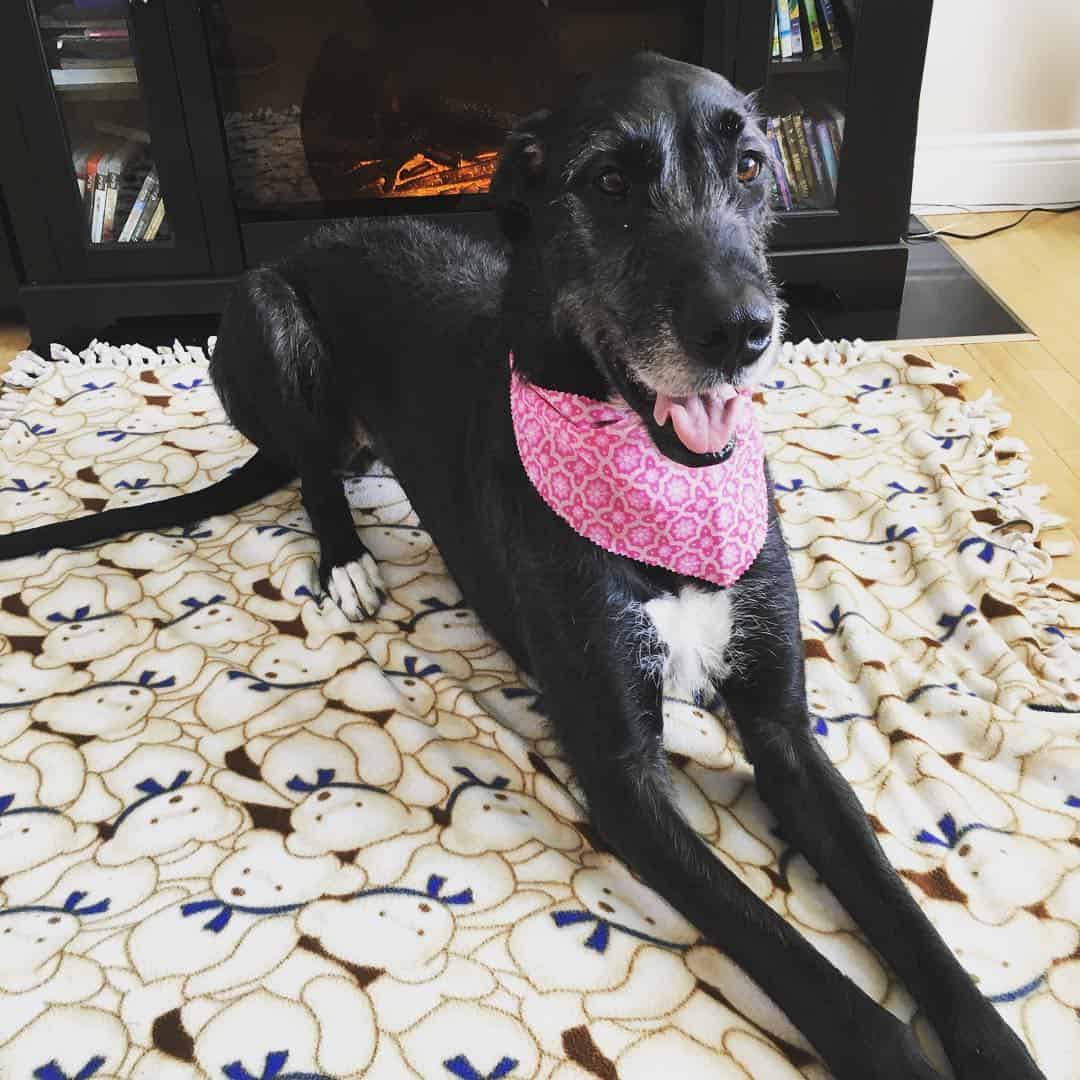
Photo from: @allbreedsandrea
You will not be able to distinguish between an Irish Wolfhound, Great Dane, or Irish Dane puppy. Since you do not know what to expect at birth, it could have a wiry, rugged coat like the IW or a smooth, glossy coat like the Great Dane in any of the dozens of colors.
Be wary of breeders who claim they have Irish Dane puppies, as no dog owner will give their AKC registered male or female for the purpose of breeding a hybrid dog. There is no way to trace back the bloodline because the parent will most likely not be registered with the AKC.
If you decide to take your chances with a breeder, make sure your vet checks the dog out before you buy it. Since you do not know what to expect from an Irish Dane puppy, the breeder will be equally clueless as to what combination will be born.
For this reason, you should definitely avoid people claiming to know how the dog will look or what its temperament will be. We are dealing with guesstimates here, so you can never be too careful. Also, avoid backyard breeders. Try checking out the conditions in which the puppies are bred first.
Conclusion
I am not sure who had the idea of creating an Irish Wolfhound Great Dane mix, but I am sure they had great expectations of the hybrid. Unfortunately, it will be some time before we can dedicate a whole article about the exact crossbreed.
So far, the information surrounding Irish Danes has been very speculative, and I cannot, in good faith, recommend you go for an Irish Dane puppy. There are simply too many blank spaces in the whole breeding process and no scientifically verified data.
Since the differences between litters with this hybrid dog can be quite polar, you are better off getting an Irish Wolfhound or Great Dane purebred puppy.
Stay curious, and keep on reading.
